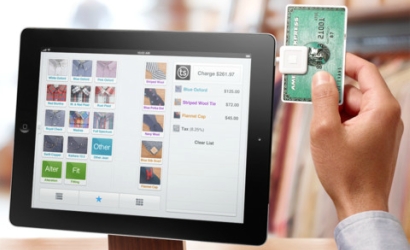Credit cards created a revolution when they first came into being — users could buy what they wanted now and then pay for it later. In fact, Forbes states that credit cards became so popular, that today almost 90% of all transactions in the US are by credit card.
 As a result, it stands to reason that almost everyone knows how the process works. You buy items and take them to checkout and the store personnel will swipe your card through a credit card reader. The reader will then create two receipts and you get to keep one receipt as proof of purchase. With the advent of POS systems, the swiping process was streamlined even more. Now it was possible to swipe the card–not on a separate terminal–but on the same machine. With the advent of iPads and iPad credit card readers from companies like Shopify, that has changed again.
As a result, it stands to reason that almost everyone knows how the process works. You buy items and take them to checkout and the store personnel will swipe your card through a credit card reader. The reader will then create two receipts and you get to keep one receipt as proof of purchase. With the advent of POS systems, the swiping process was streamlined even more. Now it was possible to swipe the card–not on a separate terminal–but on the same machine. With the advent of iPads and iPad credit card readers from companies like Shopify, that has changed again.
How do iPad credit card readers work?
Traditional POS billing systems work by retaining information on the local computer. All local systems are connected to each other and the software updates itself at the end of the day. As a result, at the end of the day, payment details are entered and a daily sales report is prepared. However, this meant that there were fixed or stationary billing centers located at particular areas in the store. Wi-Fi changed that–it was now possible to use cloud-based systems in a store. Systems are connected through an Internet connection and data is stored on the server database. As a result, at the same time, wireless enabled billing systems could be used. Large retailers like Walmart and Apple were quick to utilize these systems to speed up the billing process in a store.
Advantages of iPad credit card readers
The advantages of an iPad billing system are obvious. The system itself is small and a single tablet is the only visible device on the billing counter. When the customer approaches to pay for a purchase, the sales personnel insert a special miniaturized credit card reader into the iPad terminal. The device works the same way as a conventional credit card reader, but instead of being connected to the CPU, it is now connected to the iPad. The actual sale processing works the same way, with the sale personnel swiping the card through the miniaturized reader. Once the bank clears the sale, the receipt printer prints the sale receipt and the billing process is done.
By now you see that the entire process appears to be the same as conventional billing and there seem to be a distinct advantages over traditional billing systems. The major advantage for iPad-based POS and billing systems is that they are mobile. The tablet is integrated into the store POS system and it stores data about customers, their likes and dislikes and loyalty program details.
In the future, sales personnel can each be provided with their own sales terminal or mobile iPad POS systems with credit card readers. When the customer enters the store, the POS system will detect the customer’s mobile phone if it is Wi-Fi enabled and post data on the salesperson’s tablet. As the customer approaches items, the POS then coordinates the mobile company to provide targeted messages, discount deals and offers that encourage spot sales.
In case the customer changes his mind after viewing offers, a browsing customer is easily converted into a buying customer. Roving sales personnel can easily bill sales on the spot by just swiping cards through credit card terminals located on their iPads, and the sale is complete. As an incentive, customers may also be offered additional discounts due to their quick purchasing. Although this may seem revolutionary, it is already happening in many stores around the world, and this type of mobile purchasing and billing is expected to double or even triple in the coming years.
The Future
The use of credit card-enabled iPad systems is not just restricted to large stores. For example, Chicago small business owner Tania Ruiz of Tomate Fresh Kitchen explains that the use of a credit card-reader on her iPhone and her iPad was made necessary due to customer preferences. She was selling her products at a local farmer’s market but customers preferred to pay by credit card. As she did not have a POS or a Wi-Fi enabled billing system, she lost a lot of business. Now Ruiz uses a credit card-reader enabled smartphone at local markets and a mobile tablet-credit card reader in her store to ensure sales. Ruiz believes that these kinds of iPad credit card readers are must-haves to keep up with changing times, and they have made her business a success.
Choosing an iPad credit card reader doesn’t have to be hard. We’ll walk you through how to choose an iPad credit card reader, and how you then might choose to accessorize your iPad billing system.




